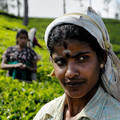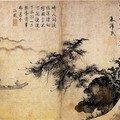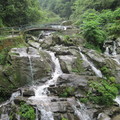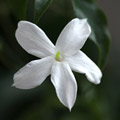Quotes - China
„At the beginning of 1990s, many small tea factories were born. Some of them started to use class level 3 (or even higher) raw tea (which was only available for emperors in the past) instead of level 6 (or even lower) raw tea (which was the traditional material for producing Pu Erh Tea).“
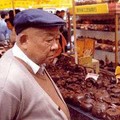
Quotes Tags: Pu-erh, Tea production, China
„Meng-Hai Tea Factory started to use the trademark "Da-Yi" around 1978. Xia-Guan Tea Factory started to register the trademarks "Song-He" and "Nan-Zhao" in 1992.“

Quotes Tags: Pu-erh, Tea production, China
„Black Puerh Tea was invented by Kunming Tea Factory in 1972/73 and was manufactured in Xia-Guan Tea Factory ever since 1976. It is now manufactured in many different factories and is by far the most popular type of puerh sold.“

Quotes Tags: Pu-erh, Shu - Ripe Puerh, Tea production, China
„Standard Tuocha tea were defined to weigh 100 gram each. Five make 1 Tong.“

Quotes Tags: Pu-erh, Tuocha, Tea production, China
„Brick Tea was mainly produced in the Si-Chuang province prior to 1949. It is now also available in other provinces as well.“

Quotes Tags: Pu-erh, Brick, Tea production, China
„In 1940, the Chinese State owned company CNNP started to manufacture Pu Erh Tea with a trademark "Zhong-Cha" at the Fo-Hai Tea Factory (now called "Meng-Hai Tea Factory"). Later, Yun-Nan Tea Company and Guang-Dong Tea Company also produced the same brand and started to export abroad. There were varieties such as red-label, green-label, yellow-label, small-letter and big-letter etc.“

Quotes Tags: Pu-erh, Tea production, China
„Mushroom shaped tea appeared in 1912. It was invented at that time in order to prevent the tea from going mouldy during the transportation. It was produced in Xia-Guan and Fo-Hai (two cities in south China) with the trademark "Bao-Yan". The production was then stopped in 1966. In 1986, the production was resumed due to the request of Buddhists in Tibet.“

Quotes Tags: Pu-erh, Mushroom - Jin Cha, Tea production, China
„Head Tea (aka Golden Melon) is shaped like a ball, weighing between 2 Liangs and 10 Jins ( 1 Jin = 500 grams). They were mainly for domestic trade or serving as tributes to emperors. Stacks of Golden Melons progressing in size from gigantic to small are considered to be a status symbol.“

Quotes Tags: Pu-erh, Tea production, China
„The most classical Puerh Tea is the Bingcha, recorded in Yong-Zheng 13th year in Qing Dynasty (1735). Each tea cake weighs 7 Liang (357 grams). Seven cakes make 1 Tong (wrapped in leaves), weighing 49 Liang. It was sold in nice places and also was exported abroad. It was re-named as "Yunnan Qizi bingcha - Yunnan seven cake tea" during the Cutural revolution.“

Quotes Tags: Pu-erh, Cake, Tea production, China
„Yunnan Tea Company standardized the trade number for Pu Erh Tea in 1976 for the purpose of export. Each bingcha has 4 digits: the first 2 digits indicate the manufacturing year, the third digit indicates the leaf grade, the last digit indicates the tea factory (e.g. Kun-Ming 1, Meng-Hai 2, Xia-Guan 3, Pu Erh 4). The loose-leaf tea has 5 digits with the third and fourth indicating the class level of raw materials. Examples of early trade numbers for Puerh Tea are 7452, 7562, 7572, 75671, 76563.“
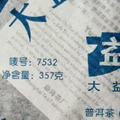
Quotes Tags: Pu-erh, Tea production, Cake, China
„zi juan; 紫娟. Purple Beauty. A purple leaved variety of Sinensis assamica which has been produced in Yunnan. “
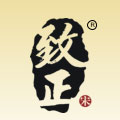
„zhang wei; 樟味 - Camphor flavour. This is sometimes present in old tea tree Puer. Due, it is said, to the presence of Camphor Laurels in tea gardens where they were planted as a form of natural pest control. “

Quotes Tags: China, Experiencing tea, Pu-erh
„yun; 韵. Charm, appeal, allure. A difficult term to render into English as it refers to a quality of tea that 'cannot be apprehended by the five senses.' Generally used with hou; 喉 - throat. Hou yun. A pleasant feeling that lingers in the throat after swallowing tea. Distinct from hui-gan. “

Quotes Tags: China, Experiencing tea, Pu-erh
„Yu Shui Cha; 雨水茶. Literally Rain water tea. Summer Tea. Less prized than Spring Tea or Autumn Tea. The flavour is usually less fulsome than Spring tea. Also, it is often oven-dried (hong qing; 烘青) as it is harvested in the rainy season.“

Quotes Tags: Tea production, China, Pu-erh
„ye sheng; 野生 - Wild, feral. Whilst there is still a comparatively large number of truly wild tea trees in Yunnan, most tea does not come from them, coming rather from arboreal trees.i.e. trees that were originally cultivated, but then left untended for many years, or bushes. “

„wo dui; 渥 - Wet, 堆 heap/pile - Wo dui - 渥堆, Literally wet -pile The process of 'pile fermentation which is used to make 'aged' Puer tea.“

Quotes Tags: Shu - Ripe Puerh, Pu-erh, Tea production, China
„tong feng; 通风 - air-flow. Puer should be stored somewhere where there is a little air movement - it doesn't need to be much. Even if it is quite humid, the airflow will guard against tea developing mould. However, care should be taken that tea is not stored in a draft which will dry the tea tea out.“

Quotes Tags: Pu-erh, Tea production, China
„tong; 筒 - Literally a barrel or barrel shaped object. A tong in Yunnan tea culture is a bundle of 7 tea cakes wrapped in the outer skin of bamboo which naturally sheds from around the base of the bamboo stem. Each cake weighs 357grams so making a total of 2,499 gm. Said by some to have been calculated in order to remain under a specific legislated weight of 2.5 kg. There were originally said to be 8 cakes in a tong. The 8th being paid as a levy. An earlier unit of weight in China was the liang. A cake of tea weighed 7 liang and 7 cakes in a tong made 49 liang. “

Quotes Tags: Pu-erh, Tea production, Yunnan, China
„tian xiang; 甜香 - 甜, tian - sweet.香, xiang - fragrant. Used to refer to Puer tea that has a sweet - fragrant flavour “

Quotes Tags: Pu-erh, China, Experiencing tea
„tai di; 台地 - Literally mesa or plateau.台地茶 tai di cha refers to tea bushes that have been planted and are still young. They are also the broad leaf varietal and have generally been grown from the seeds of old trees. They are not inherently bad, but the use of chemicals in their cultivation is pervasive.“

Quotes Tags: China
„tan qing; 摊青 - The process of laying freshly picked leaves out to allow the moisture content to diminish before frying“

Quotes Tags: Tea production, China
„shi cang; 湿仓 - wet storage. Storage that is intentionally humid. Done in order to attempt to speed up the ageing process of Puer tea. It has risks associated with it from effectively shortening the 'life' of the tea, having a deliterous effect on the plant constituents - not least the aromatics compounds to ruining the tea altogether.“

Quotes Tags: Pu-erh, Tea production, China, Experiencing tea
„sheng; 生 - Raw, uncooked, un-processed. Here used to refer to Puer tea that is made from maocha that does not undergo further processing, other than steaming and pressing where it is made into cake, brick, etc. form.“

Quotes Tags: Sheng - Raw Puerh, Pu-erh, China
„shai qing; 晒青 - Sun dried. This is a critical aspect of Puer Tea processing. Oven dried tea is considered inferior to sun-dried. The Provincial Government has ruled that Puer tea must be sun-dried.“

Quotes Tags: Pu-erh, Tea production, China
„sha qing; 杀青. Literally to kill. So 杀青 translates as killing green. The process of pan 'frying' fresh tea arrests the action of plant enzymes that will have begun after picking.“

Quotes Tags: Tea production, China
„Qing Ming Cha; 清明茶.said to be tea that is picked three days either side of the springtime festival - Qing Ming Jie 清明节- Grave Sweeping Festival which falls on April 4th and 5th.“

Quotes Tags: China
„Yunnan Provincial Government has stipulated that for tea to qualify as Pu er it must be:
i) of the Broad Leaf variety (Sinensis Assamica)
ii) grown in the Lancang (Mekong) River region
iii) sun dried. The third point is important as there is much tea grown in the Lancang River area that is not sun dried.
There are also increasing amounts of Small Leaf Variety (Xiao Ye Zhong /小叶种) being grown in the Lancang River area.“

Quotes Tags: Pu-erh, Tea production, Yunnan, China, Lancang
„Pu'er Tea; 普洱茶. That 'Puer Tea' was given this name suggests that historically this kind of tea - post fermented camelia sinensis assamica must have come from the south and west of Puer for there to have been any sense in transporting it through that city. The majority of good Puer tea still comes from the Xishuangbanna region. Puer County itself was not an historically important tea producing region.“

„Pu'er; 普洱. Also Puerh, Pu - er etc. Pu'er is the modern pinyin spelling. The place name of the Old City of Pu'er through which pack horses transported the tea from Southern Yunnan. The names were recently changed; Pu'er is now Ning Er and nearby Simao has the adopted name of Pu'er. Locally, in spoken Chinese at least, Ning Er is still Pu'er. “

„ping wen; 平稳. Smooth, steady, even. Used to refer to the taste of tea. Puer should be smooth and steady without any sudden changes in the flavour as steepings progress. A sudden change or loss of flavour is an indicator of poor quality. Good Puer can be steeped 20 to 30 times and maintain it's flavour. “

Quotes Tags: Pu-erh, China, Experiencing tea
„pin pei; 拼配. A blend or mix. pin pei Puer comes in many forms; tea from a particular place, but comprising of old tea tree leaves mixed with tea bush leaves or, old tree tea from different areas or seasons mixed together, or finally, a combination of all of the above. “

Quotes Tags: Tea production, China
„Pang xie jiao; 旁鞋脚. Latin; (Viscum articulatum Burm.f.) Literally Crabs legs. A parasitic plant that grows on trees in sub-tropical regions. When it grows on the tea tree it absorbs flavour from the tree and makes a sweet, refreshing drink, hot or cool. Very limited availability. Puer cakes can be found that have Pangxiejiao mixed into the cake. Normally around 10-15%. It is also part of the Chinese medicine pharmacopoeia – said to have a diuretic effect and is used to clear heat“

Quotes Tags: Pu-erh, Tea production, China, Health
„nei xiang;内香 - refers to a kind of fragrance that is not 'yang' or obvious. Often not perceived till after the tea has been swallowed. Sometimes also 幽香 - you xiang.“

Quotes Tags: China, Experiencing tea, Pu-erh
„mao cha; 毛茶 - Tea that has been dry fried in a tea wok & then rolled & dried.“

Quotes Tags: Tea production, China, Maocha
„Ku Cha; 苦茶 - Bitter Tea. The tea from a variety of tea tree (Camelia Sinensis Assamica var.Kucha) found in an area around Mensong.“

Quotes Tags: China, Experiencing tea, Pu-erh
„ku se; 苦涩 - Bitter and astringent. The nature of new raw Puer is a little astringent and bitter, followed by a sweet aftertaste. However, a bitterness with no sweet aftertaste is not typical of Puer and an astringency which is not comfortable would not be considered good tea. “

Quotes Tags: Sheng - Raw Puerh, Pu-erh, China, Experiencing tea
„kou gan; 口感 - Literally mouth-feeling. Dictionary definitions vary between mouth-feel referring strictly to textural character - i.e. 质地/zhi di, others to a broader definition of flavour. In tea drinking it is largely referring to the former, but cannot be easily separated from other gustatory and olfactory sensations.“

Quotes Tags: China, Experiencing tea, Pu-erh
„ji qi sha (de); 机器杀(的) - Machine fried. Most tea famers have a machine for the sha qing process, which is generally an electrically driven revolving drum, fired by a wood fire. Machine fried tea is probably better than poorly hand fried tea, but lacks the possibility of the more tactile method of hand frying.“

Quotes Tags: Tea production, China
„ji qi rou (de); 机器揉(的) - Machine rolled. Some machine rolled tea has a very pleasing appearance and most tea gardens, however small, will have a machine, which is generally electric, but sometimes hand operated. However, the best sheng puer tea is still hand rolled.“

Quotes Tags: Tea production, China
„hou long; 喉咙 - The throat. Often used in describing the experience of tea drinking. A pleasant feeling in the throat is a key factor in evaluating the quality of tea; 喉咙舒服/喉咙不舒服 - a comfortable or uncomfortable feeling in the throat.“

Quotes Tags: China, Experiencing tea, Pu-erh
„hou fajiao; 后发酵 - Post-fermented. 后hou - behind, after. 发; fa - has many meanings; to develop, expand, bring into existences, start; rise or expand when fermented. 酵 jiao - fermented. Together 发酵 means to ferment. Confusion often arises as the term fajiao is used to refer to both processes of fermentation and oxidation. The more specific term yang hua - 氧化 refers specifically to oxidation.“

Quotes Tags: Tea oxidation, Tea production, China
„hun he; 混合 - A mix or blend. Perhaps with some derogatory connotation. Used by some to refer to pin pei cha. i.e tea that is not pure; not tea from one single place, season and/or type of tree. e.g. old tree tea leaves from two or more places , or tea from the same place but not only from old or ancient trees or bushes, or from different seasons. “

Quotes Tags: Tea production, China
„hui gan; 回甜 - Hui 回- return, come back, reply. 甜, gan-sweet. Together - sweet return, sweet aftertaste. Used generally to refer to the aftertaste of tea, be it sweet or not.“

Quotes Tags: Tea infusion, China, Experiencing tea, Pu-erh
„hong qing; 烘青. Oven dried. Oven dried tea is generally felt to be inferior to sun-dried. However, most tea producers have one, often wood fired, oven, which is used to dry leaves if time or weather does not permit sun or air drying. “

Quotes Tags: Tea production, China
„hong; 红 - red. In China, what is called black tea in the English speaking world, is called red. Cooked Puer is sometimes mistakenly referred to as a black tea.“

Quotes Tags: Shu - Ripe Puerh, Red tea, Black tea, Pu-erh, Tea production, China
„guan mu; 灌木 - Literally means bush or shrub. 灌 - guan, to irrigate. This style of cultivation is relatively new in Yunnan, having only started in the early to mid 20th Century. Tea bushes are cultivated in rows. Guan mu cha is the tea from cultivated bushes.“

Quotes Tags: Tea production, Yunnan, China
„gong fu; 功夫 - The skill or art of tea making. The same two characters are used to refer to other fields of skill development. Most commonly to the field of self defence.“

Quotes Tags: Tea infusion, Yunnan, China
„gaiwan; 盖碗 - literally lid-bowl. A steeping bowl with a lid. They generally come in two or three sizes. The most common is 140cl/4oz. The lid is used to clear off any extraneous materials that may float to the surface on flushing and initial steepings. These (1 or 2) are typically not drunk. The lid is then used to partially strain the tea by holding it a little to one side as one pours the tea off through a fine strainer into a gong dao bei (共道杯) or decanting jug.“

Quotes Tags: Tea infusion, China
„gan cang; 干藏 - dry storage. Referring to tea storage that tends to be dry rather than excessively humid. Storing raw Puer in an excessively dry climate will have a harmful effect on the tea.“

Quotes Tags: Sheng - Raw Puerh, Pu-erh, China, Experiencing tea
„gan; 干 - dry. Sometimes used to describe a certain feeling in the mouth, typically on the tongue or in the throat that is either due to the nature of the tea, or the way it has been processed or stored. Distinct from astringrent. See also 燥/zao“

Quotes Tags: China, Experiencing tea, Pu-erh
„fa jiao; 发酵 - To ferment/fermented. Shu Puer tea is a made by a process of fermentation. Raw puer is referred to as hou fa jiao cha - post-fermented tea -which technically is said to be a mix of oxidation and fermentation.“

Quotes Tags: Sheng - Raw Puerh, Pu-erh, Tea production, China
„Dian Hong; 滇红. 滇 - Dian is an old name for Yunnan. So Yunnan Black Tea. “

„da ye; 大叶 - literally big leaf. The Chinese term for the broad leaf varietal camelia sinensis assamica.“

Quotes Tags: Tea production, China
„da shu; 大树 - 大,da -big,old. 树, shu- tree. Big/old tree. A term used to refer to trees that could be anything from say 30 old years to 70 yrs old. Many different places have their own approach, so there appears to be no fixed definition of what qualifies as da shu. See Gu shu. “

Quotes Tags: Tea production, China
„da piao; 大票 - large ticket. The bigger loose label or ticket which is found inside a tea cake wrapper “

Quotes Tags: China, Pu-erh, Tea production
„chun cha; 春茶 - spring tea. Normally divided into periods; 头春; tou chun/first flush, 二春; er chun/second flush, 春尾chun wei, tale of spring. Also see 波-bo is also used. chun; 纯 - pure. not pin pei“

Quotes Tags: Tea production, China
„chui niu; 吹牛. 吹 - chui, to blow. 牛 - niu, cow, but in this case can be read as 公牛 or bull. An almost default aspect of tea drinking - 'shooting the bull'. The talk that often accompanies tea drinking and can be peppered with much knowledge, a little exaggeration and some humour. Also 吹牛皮. 皮 - skin or hide. 'Blowing the bulls hide.'“

Quotes Tags: Teahouse, China, Experiencing tea, Pu-erh
„chen wei; 陈味 - Aged, mellow. An expression which in Chinese can be used to refer to the flavour of aged alcohol, tea, etc. “

Quotes Tags: China, Experiencing tea, Pu-erh
„cha zhuan; 茶砖 - Tea brick 砖 has石shi as a radical which means stone or something to do with stone, so a brick shape of material from the ground, but the wider meaning of brick is a brick shape of any material.“

Quotes Tags: China
„cha yuan; 茶园 - Tea garden. Commonly used to refer to a tea plantation.“

Quotes Tags: Tea production, China
„cha yi; 茶仪 - Tea ceremony. Not generally used to refer to the daily habit of tea making and drinking. Most habitual tea drinkers would be unlikely to use this term in reference to their tea-making activities. Not common parlance in Yunnan tea making circles“

Quotes Tags: Tea infusion, China, Experiencing tea, Pu-erh
„cha ya; 茶芽. Tea tip/s. 芽 - ya literally means tooth, So the new shoots of tea leaves. These are generally the most prized, followed by other less exquisit formations such as yi ya yi ye,一牙一叶 and yi ya liang ye, 一牙两叶, etc.“

Quotes Tags: China
„cha wan; 茶碗 - Tea bowl. This is typically a small handle-less bowl made from porcelain, terracotta or glass. As with Yixing pots, anything that is pourous is going to absorb flavours and should ideally be dedicated to one kind of tea.“

Quotes Tags: China
„cha shi; 茶室 - Literally tea room. A tea shop. Also sometimes a brothel. Japanese friends who were so acquainted have told me that in China Town in Bangkok, up until a few years ago, there were a handful of such establishments, where one ostensibly went to drink tea, but could avail oneself of further diversions. Apparently, the tea was not up to scratch.“

Quotes Tags: Tea infusion, Teahouse, China
„cha qi; 茶气 - Tea nature. The inherent energetic qualities in tea. That which makes it tea. Sometimes rather unsatisfactorily interpreted as 'tea energy'; translating qi as energy suggests perhaps a rather too narrow idea of qi but it is an interesting term to consider since many people use the term. Ideas and experiences of cha qi vary considerably; the taste of tea, the appearance of the leaves (particularly after steeping i.e. the life in the tea), any physical or psychological experiences one may have as a result of drinking tea are all aspects of cha qi. One cannot satisfactorily dissociate one from the other just as one cannot isolate sunshine from wind, which are both manifestations of weather, tian qi. If it did not have cha qi it wouldn't be tea, it would be something else. From a western point of view perhaps, cha qi is due, in some good part, to the presence of caffeine, theine, etc. The active constituents.“

Quotes Tags: China, Experiencing tea, Pu-erh
„cha pan (zi); 茶盘(子) - Tea tray. The tray with a drainage system - normally a simple pipe- that is used when making tea. Usually made from bamboo, wood or stone.“

Quotes Tags: Tea infusion, China
„cha men (zi); 茶闷(子) - Another term for Gaiwan. 闷;men - to cover tightly.“

Quotes Tags: Tea infusion, China
„cha ju; 茶具 - Literally tea-tools. The paraphernalia for making tea gong-fu style“

Quotes Tags: Tea infusion, China
„cha hu; 茶壶 - Tea pot. Made of porcelain, pottery or glass. Yixing pots are used for both cooked and raw Puer. Since they are pourous, the pots absorb flavours and chemicals from the tea. If one is serious about using Yixing pots, particularly for sheng Puer, one needs to be ready to get at least two pots - one for older and one for younger teas. And these should not be used for brewing other teas, and vice-versa. Yixing teapots will typically soften the flavours of sheng Puer.“

Quotes Tags: Sheng - Raw Puerh, Shu - Ripe Puerh, Tea infusion, China
„cang wei; 仓味. The flavour of tea that has been stored (poorly). Often used to refer to the aroma of 'Wet Stored' tea.“

Quotes Tags: China, Experiencing tea, Pu-erh
„bo; 波 - wave. The term 波-bo here has the same meaning as flush: 第一波, di yi bo ,第二波, di er bo, and so on“

Quotes Tags: China
„bing; 饼 - cake. Something shaped like a cake. 茶饼; cha bing - tea cake. This is a cake of tea that has been pressed by hand or machine into a compact form. Easy for transporting and storage. The more tightly pressed it is, the slower the tea will age. They can range in size from 100 gms to several kilograms.“

Quotes Tags: Pu-erh, Tea production, China
„bao, 薄 - thin, flimsy, weak. Used to describe tea that is lacking in flavour, body, 'thickness'. “

Quotes Tags: China, Experiencing tea, Pu-erh
„ba qi , 霸气 - . ba - 霸 means hegemonic, overlord or despot. So ba qi means strong, aggressive qi. Used to refer to a certain quality of qi in tea.“

Quotes Tags: China
„Hui Gan 回甘, Hui Tian 回甜, Sheng Jin 生津, & Hui Yun 回韻…In literally term, Hui Gan, sometimes referred to as Hui Wei, is to reflect sweetly on a past event. Borrowing from the term 'to reflect', Hui Gan in tea is, simply put, a reflection on the sweetness of the tea - when one drink the tea, when the tea slides through the cavity of the mouth into the throat, there comes, after a short while, a sweetness that rises up from the throat. This sweetness is sometimes accompanied with a fragrance. Do not keep the upper and lower mouth pressed together when sipping tea, but create a cavity instead by lowering the jaw. Let the tea wash over the entire inside of the mouth, and then direct the tea to slide from the sides of the jaw into the throat. While holding the empty cavity, breathe out instead of in after you swallow the tea, there is warmth in the breath accompanied by a fragrance, and the same fragrance that rises up from the throat. This is Hui Gan.“
Quotes Tags: Pu-erh, China, Tea infusion, Experiencing tea
Teas
Lao Banzhang 2004 Bamboo Tube
 1 review
1 reviewLao Banzhang 2004 is a pu-erh pressed into bamboo tubes. Mighty and rich tea soup reminds us its great...
2013 Early Spring Premium Yunnan Mao Feng
 1 review
1 reviewGrade: AA+ Cultivar: Yunnan Da Ye Harvest area: Si Mao, Yunnan Yunnan green tea produced...
2012 Menghai "Spring of Menghai" Raw Pu-erh
 1 review
1 reviewPremium blend of first flush of spring tea * Batch 201This is a newer Menghai release, first...
Theme
Tea by region
We will help you with tea selection.
Do you like quality loose tea?
We will help you to find the right one for you. Be inspired by tea ratings of other tea lovers. Rating stars could help you.


Review your cup of tea.
Review the tea you are drinking and help other tea lovers to find the right cup of tea.



Quotes
„Pu'er Tea; 普洱茶. That 'Puer Tea' was given this name suggests that historically this kind of tea - post fermented camelia sinensis assamica must have come from the south and west of Puer for there to have been any sense in transporting it through that city. The majority of good Puer tea still comes from the Xishuangbanna region. Puer County itself was not an historically important tea producing region.“



 Shops
Shops Share on Facebook
Share on Facebook






